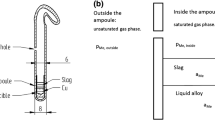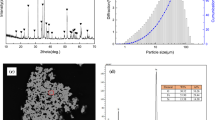Abstract
The steel industry is regarded as the most critical industry in the nation and is crucial to economic prosperity; however, its high energy use and carbon emissions significantly impact climate change and global warming. In view of achieving carbon neutrality, one of the most promising technologies is using green hydrogen gas as a reductant for producing carbon emission-free direct reduced iron (H-DRI) from iron ores/pellets. Moreover, the produced H-DRI is subsequently used for steel making in the induction furnace/electric arc furnace. However, the study on the melting behavior of H-DRI, interaction among slag and metal produced from H-DRI with refractory during the steel making in induction furnace/electric arc furnace has yet to be thoroughly studied. Therefore, in this study, DRI’s dissolution/melting behavior in the liquid iron at 1600 ± 10 °C has been studied. Then, interactions among slag generated during the melting/dissolution of DRI, refractory of the induction furnace, and metal produced from H-DRI have been studied using the SEM backscatter electron method. The thermodynamics modelling for the slag formation and interactions among slag-metal-refractory systems have been studied using FactSage 8.2. The penetration of iron from a liquid melt into porous refractory and the formation of complexes like mullite, spinal, and olivine has been observed. The boundaries between the slag-metal-refractory system and the dissolution of Mg and Fe have been identified using backscattered electron mode. Thermodynamics modelling has been validated with experimental observations.
Graphical Abstract


















Similar content being viewed by others
References
Bhaskar A, Assadi M, Somehsaraei HN (2020) Decarbonization of the iron and steel industry with direct reduction of iron ore with green hydrogen. Energies 13(3):1–23. https://doi.org/10.3390/en13030758
Kim W, Sohn I (2022) Critical challenges facing low carbon steelmaking technology using hydrogen direct reduced iron. Joule 6(10):2228–2232. https://doi.org/10.1016/j.joule.2022.08.010
Shahabuddin M, Brooks G, Rhamdhani MA (2023) Decarbonisation and hydrogen integration of steel industries: recent development, challenges and technoeconomic analysis. J Clean Prod 395:136391. https://doi.org/10.1016/j.jclepro.2023.136391
Delbeke J, Runge-Metzger A, Slingenberg Y, Werksman J (2019) The paris agreement. Towards a climate neutral Europe: curbing the trend. Routledge, London, pp 24–45
Madhavan N, Brooks G, Rhamdhani MA, Bordignon A (2022) Contribution of CO2 emissions from basic oxygen steelmaking process. Metals 12(5):797. https://doi.org/10.3390/met12050797
Vogl V, Åhman M, Nilsson LJ (2018) Assessment of hydrogen direct reduction for fossil-free steelmaking. J Clean Prod 203:736–745. https://doi.org/10.1016/j.jclepro.2018.08.279
Accenture (2017) Steel demand beyond 2030. Steel demand beyond 2030—forecast scenar, pp. 24–25. https://www.oecd.org/industry/ind/Item_4b_Accenture_Timothy_van_Audenaerde.pdf
Lopez G, Farfan J, Breyer C (2022) Trends in the global steel industry: Evolutionary projections and defossilisation pathways through power-to-steel. J Clean Prod 375:134182. https://doi.org/10.1016/j.jclepro.2022.134182
Cavaliere P (2019) Clean ironmaking and steelmaking processes. Springer, Cham
Spreitzer D, Schenk J (2019) Reduction of iron oxides with hydrogen—a review. Steel Res Int. https://doi.org/10.1002/srin.201900108
Patisson F, Mirgaux O (2020) Hydrogen ironmaking: how it works. Metals 10(7):1–15. https://doi.org/10.3390/met10070922
Vickerfält A, Huss J, Martinsson J, Sichen D (2023) Reaction mechanisms during melting of H-DRI focusing on slag formation and the behavior of vanadium. Metall Mater Trans B 54(4):2206–2215. https://doi.org/10.1007/s11663-023-02827-z
Vickerfält A, Martinsson J, Sichen D (2021) Effect of reduction degree on characteristics of slag formed by melting hydrogen-reduced DRI and partitions of P and V between slag and metal. Steel Res Int 92(3):21–24. https://doi.org/10.1002/srin.202000432
Huss JKJ, Vickerfält A (2023) Some Aspects of the melting and dephosphorization mechanism of hydrogen-DRI. Steel Res Int 94:1–10
Li S et al (2023) Microstructural evolution during H2 corrosion of Al2O3–SiO2 based refractory aggregates. Ceram Int 49(17):27788–27795. https://doi.org/10.1016/j.ceramint.2023.05.265
Ayyandurai A, Pal J (2022) Reaction mechanism of in-situ carbon in hematite ore pellet during induration. Miner Process Extr Metall Rev 43(1):40–54. https://doi.org/10.1080/08827508.2020.1825954
Ayyandurai A, Pal J (2022) Blast furnace flue dust as a potential carbon additive in hematite ore pellet. Miner Process Extr Metall Rev 43(5):633–647. https://doi.org/10.1080/08827508.2021.1914607
Bale CW et al (2009) FactSage thermochemical software and databases—recent developments. Calphad Comput Coupling Phase Diagrams Thermochem 33(2):295–311. https://doi.org/10.1016/j.calphad.2008.09.009
Sarkar R, Nash BP, Sohn HY (2020) Interaction of magnesia-carbon refractory with metallic iron under flash ironmaking conditions. J Eur Ceram Soc 40(2):529. https://doi.org/10.1016/j.jeurceramsoc.2019.09.019
Sarkar R, Nash BP, Sohn HY (2018) Interactions of alumina-based and magnesia-based refractories with iron melts and slags: a review. J Eur Ceram Soc 49(2):529–541. https://doi.org/10.1007/s11663-018-1300-1
Acknowledgements
The authors sincerely thank the Director of CSIR-National Metallurgical Laboratory for permission to publish the paper. The authors also thankfully acknowledge the financial assistance offered by the i-PSG Committee of CSIR-National Metallurgical Laboratory, Jamshedpur, to conduct this investigation.
Author information
Authors and Affiliations
Corresponding author
Ethics declarations
Conflict of interest
The authors declare that they have no conflict of interest.
Additional information
The contributing editor for this article was Il Sohn.
Publisher's Note
Springer Nature remains neutral with regard to jurisdictional claims in published maps and institutional affiliations.
Rights and permissions
Springer Nature or its licensor (e.g. a society or other partner) holds exclusive rights to this article under a publishing agreement with the author(s) or other rightsholder(s); author self-archiving of the accepted manuscript version of this article is solely governed by the terms of such publishing agreement and applicable law.
About this article
Cite this article
Ammasi, A., Rahul Karthik, P.M. & Vishal, D. Slag-Metal- Refractory Interactions During Dissolution of Hydrogen-Based Directly Reduced Iron (H-DRI) in Liquid Iron Melt. J. Sustain. Metall. (2024). https://doi.org/10.1007/s40831-024-00802-9
Received:
Accepted:
Published:
DOI: https://doi.org/10.1007/s40831-024-00802-9




